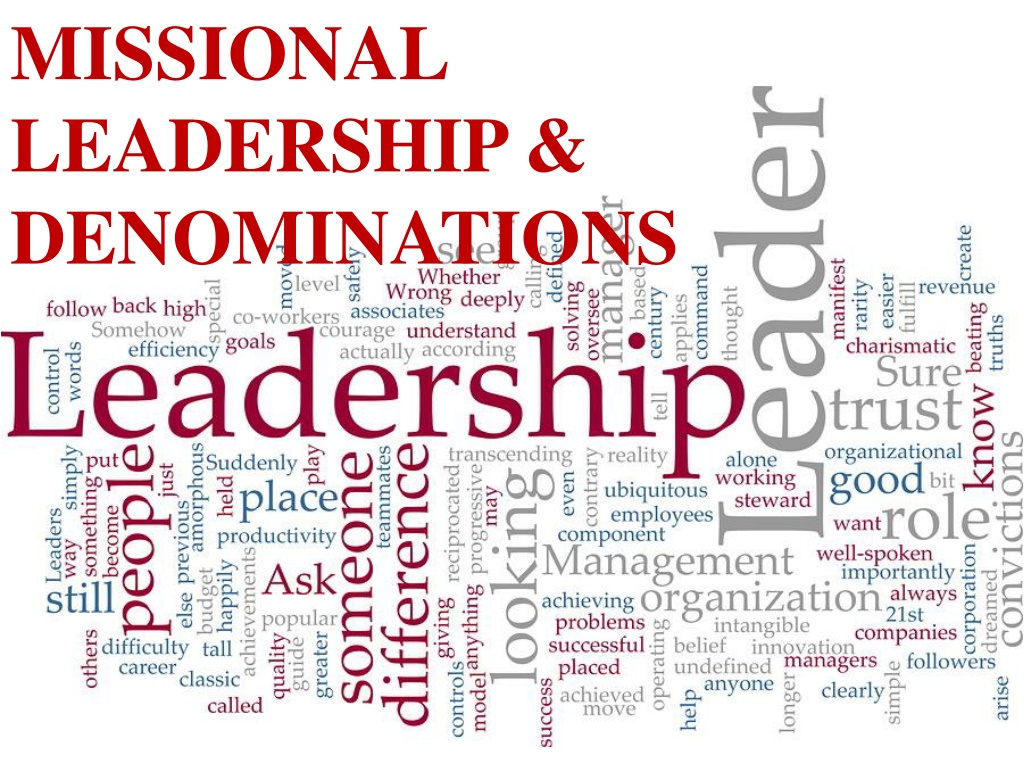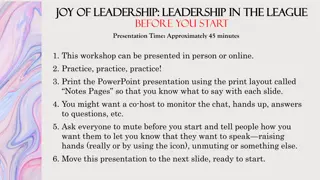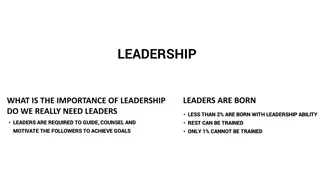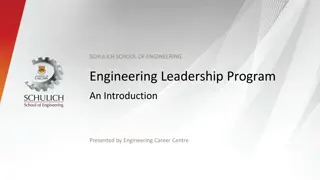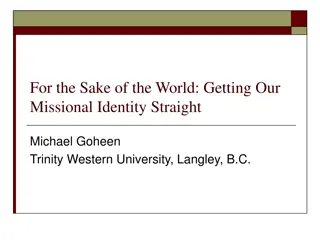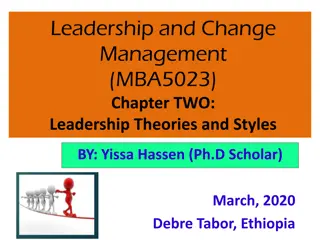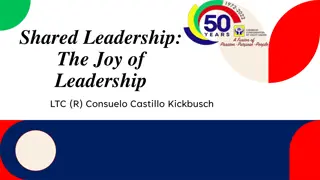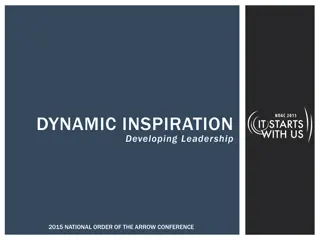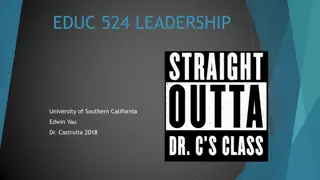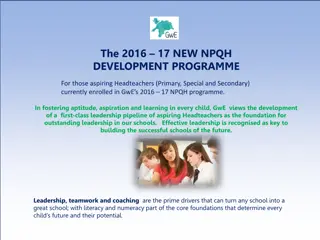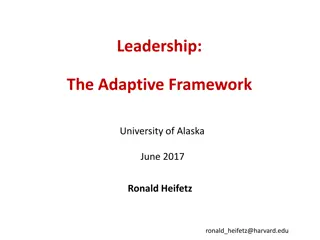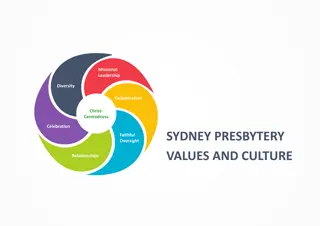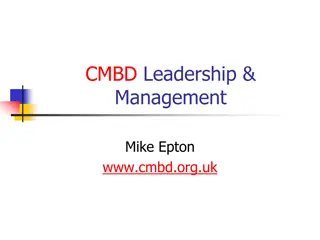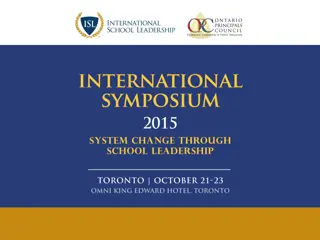Missional Leadership & Denominations Overview
Dive into the experience of missional transformation in two denominational structures - The Highveld Synod and the General Synod of the DRC, exploring the crucial role of leadership in driving this transformation.
Download Presentation

Please find below an Image/Link to download the presentation.
The content on the website is provided AS IS for your information and personal use only. It may not be sold, licensed, or shared on other websites without obtaining consent from the author. Download presentation by click this link. If you encounter any issues during the download, it is possible that the publisher has removed the file from their server.
E N D
Presentation Transcript
MISSIONAL LEADERSHIP & DENOMINATIONS
AGENDA AGENDA 1. A brief overview of my experience of missional transformation in two denominational structures the Highveld Synod of the DRC and the General Synod of the DRC. 2. To show that there is no missional transformation without leadership. 2
AGENDA AGENDA 3. To show that the missional transformation of denominations is dependent on transformational leadership. 4. To describe transformational missional leadership appropriate for denominations in terms of my experience in and with the DRC, with reference to complex leadership . 3
METHODOLOGY METHODOLOGY My own experience of, and ideas about, missional church has been deeply influenced by my experience in two denominational structures : Highveld Synod and General Synod. 4
METHODOLOGY METHODOLOGY My approach will be to refer to the fact that both of these synods did indeed embark on a missional journey, and that the length and depth of this journey can only be appropriated in terms of the observer's point of view. 5
METHODOLOGY METHODOLOGY In the DRCdecisions of the synod are important in a number of ways. Official decisions, policy documents, and vision statements represent a reflection on the dominant language - and thus imagination - of the synod. I will be focusing specifically on the denominational language used by, and the decisions made by, the two synods as mentioned above. 6
Church governance and polity must reflect ecclesiology. If the church is missional by its very nature, the challenge will clearly be to express this missional character in church polity.
OVERVIEW IN DRC OVERVIEW IN DRC Highveld Synod 2005 1. The Synod decides to assist its congregations to be a more missional church by (a) reaching out to communities, and (b) by attending to a ministry that provides for diversity; 2. The Synod decides to commit itself as a partner to the South African Partnership for Missional Churches; 8
3. The Synod decides to expand its existing call (vision statement) to the following: "the Synod of Southern Transvaal (a) guides congregations to honour God, one another, and to serve the world with the love of Christ; and (b) guides congregations in order for the Dutch Reformed Church in Southern Transvaal to be enabled to grow into a missional church for the sake of the community
4. The Synod accepts it as a strategic focus to assist church leadership in discerning the signs of the times, and equipping them for being a church of the future.
2014 1. Awareness processes for congregations to understand the need for cultural change from maintenance to missional, as well as the beneficial future of a missional imagination versus the dangers of a continuation of the status quo. 2. Inspiration to participate and support missional transformation.
2014 3. The transfer of knowledge in terms of missional capacities and missional leadership. 4. The implementation of missional leadership and processes in local congregations. 5. Establishing sustainable transformational capacities by supporting and strengthening missional capacities and skills
OVERVIEW IN DRC OVERVIEW IN DRC General Synod 1. 2011 policy document - Missional Ecclesiology . 2. Raamwerkdokument oor die Missionale Aard en Roeping van die NG Kerk (Framework document on the missional nature and calling of the DRC). The goal of the report was stated to be "the creation of new missional language that may ignite new imagination for the DRC" 13
New insights into God The Trinity introduces us to a sending God who is a missionary God. Mission is thus understood as an activity of the triune God
missio Dei The life of the Trinity is a missional life, and the communion in the Trinity is a communion that flows outward. This provides the framework for Christian mission.
Missional church The church is a missional church and participates in God s mission.
Incarnation Self-giving typifies the life of the Trinity, and self-giving is at the heart of the divine mission to the world. The incarnation should therefore also serve as a model for the church.
Contextualising the church The fundamental importance of the incarnation as a movement towards where people are, demands an appreciation of the world and the context.
Diaconal work The kenotic life of Jesus, his self- sacrifice, as well as the Father s sending of the Son, is the very basis of all service.
Praxis Van Niekerk (2014:4) summarises the key elements of this document: "Two key terms are found in this formulation: the restoration of relationships, and the way we live".
Changes in church order 2. The Dutch Reformed Church is called by the Triune God to participate in God s mission in the world. The Church is equipped by the Holy Spirit to serve God s honour and to proclaim the ministry of reconciliation and the salvation through Christ.
Summary Van Niekerk identifies a paradigm shift to a new understanding of the content and character of mission; one where the local congregation itself is sent to its local context, where its members live and work from day to day.
Transformational leadership MISSIONAL CHURCH
ROLE OF LEADERSHIP ROLE OF LEADERSHIP There is no missional transformation without missional leadership. Current research values leadership as the most important contributing factor towards the formation of a missional congregational culture (Cordier 2014:186-190; Keifert 2007:86; Hendriks 2009:117; Sheridan and Hendriks 2013:11; and Barrett 2004: x-xi), and I am convinced that it is also valid in the case of denominational transformation. 24
ROLE OF LEADERSHIP ROLE OF LEADERSHIP Missional leadership is transformative leadership. 25
OSMER ON LEADERSHIP Task competence Transactional leadership Transforming leadership
Transforming leadership Leading an organisation through a process of "deep change" in its identity, mission, culture, and operating procedures. It involves projecting a vision of what the congregation might become, and then mobilizing followers who are committed to this vision.
MISSIONAL LEADERSHIP MISSIONAL LEADERSHIP The Spirit-led transformation of people and institutions, by means of meaningful relations, to participate in God s mission. 28
TRINITARIAN TRINITARIAN PNEUMATOLOGICAL PNEUMATOLOGICAL Missional leadership is living in the Trinity, because a missional church is founded and energised by the life of the Trinity. Mission provokes in us a renewed awareness that the Holy Spirit meets us and challenges us at all levels of life, and brings newness and change to the places and times of our personal and collective journeys. 29
COMPLEX LEADERSHIP COMPLEX LEADERSHIP 30
COMPLEX SYSTEMS COMPLEX SYSTEMS A denomination can be regarded as a complex organic system, as described by Plowman et al (2007). They argue that emergent self-organization is a central principal of complexity theory. 31
(1) they are made up of many agents who act and interact with each other in unpredictable ways, (2) they are sensitive to changes in initial conditions, (3) they adjust their behaviour in the aggregate to their environment in unpredictable ways,
(4) they oscillate between stability and instability, and (5) they produce emergent actions when approaching disequilibrium. Additionally, complex systems are dynamic and non-linear, and rarely explained by simple cause effect relationship (Plowman et al, 2007:342-343).
COMPLEX CHURCH COMPLEX CHURCH I regard the church, as well as denominational structures, as complex systems; not only in terms of organisational theory, but also, and primarily, because the church finds its identity in the activity of the Holy Spirit (Peterson 2013:5). The Holy Spirit is present with us, yet never domesticated or tamed (WCC 2013:58). 34
COMPLEX LEADERSHIP COMPLEX LEADERSHIP 35
What, then, is the role of leadership in a complex organization such as denominational structures? If leaders, even church leaders, cannot predict and control the organiSation s future, what can leaders do? How did the DRC arrive at a point where a policy document on being a missional church has been adopted by the denomination?
PLOWMAN ON LEADERSHIP Leaders disrupt existing patterns Encourage novelty Act as sensemakers
Disrupting existing Disrupting existing patterns patterns 1. Leaders create and highlight conflict - communicating the emerging new future of the organisation, which introduces further disruptions into the system 2. Leaders acknowledge uncertainty - force the participants in systems to face its troubling future. 38
DRC I was quite surprised by the findings of Plowman et al, and immediately recognised the mechanism of disruption as well as the actions of conflict and acknowledging uncertainty.
Conflict and a diversity of viewpoints are definitely present in the DRC: paradigm-shifting choices on gay- gender, church confessional issues. unity, and 40
Visibility new future of the church: Highveld Synod decided to work with a paradigm that focuses on God s preferred future for the church, and to bring hope in times of uncertainty . to the emerging 41
General Synod: declaration of calling at the 2002 synod, followed by a declaration of commitment at the General Synod of 2004. 42
Leadership acknowledges uncertainty: Highveld - values that included the following: to embrace risks, to allow each other to make mistakes, and to acknowledge that the church does not have all the answers to the issues posed by changing contexts 43
Leadership acknowledges uncertainty: The General Synod's leaders did not shy away from unpredictable or unexplicable outcomes either, as is evident in the case of the decisions made regarding homosexuality 44
Encouraging novelty Encouraging novelty "Traditional leaders" operate as controllers, by leading through command and control. "Complex leaders" encourage innovation, establish simple rules, and act as enablers of emergent, self-organization by encouraging innovation. A paradoxical leadership approach. 45
Encouraging novelty Encouraging novelty 1. The establishment of a few simple rules. Complex leaders are clear about the core issues, but ambiguous in terms of the rules as to how to achieve it. 2. Swarm behaviour of membership and staff. 3. Promotion of non-linear interactions and emotional connections among people 46
The context of both denominations can be described as a system where a multitude of rules dominate, in terms of the rules and regulations contained in the church order. 48Simple rules
Highveld Synod = it becomes clear that there was a concious suspension of some of these rules, and perhaps even cases where a blind eye was turned to the multitude of rules that usually govern synods and meeting 49Simple rules
Ungerer (2009:32) describes the process in the synod as follows: they decided to use a more conversational method for discussions by participants the so-called Large Group Interactive Event. Swarm behaviour 50
